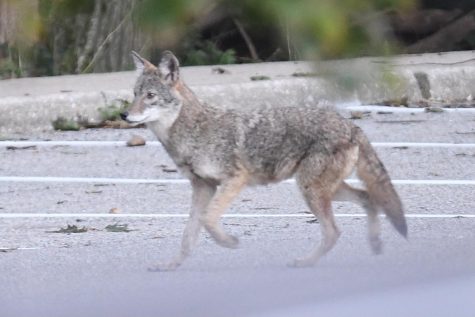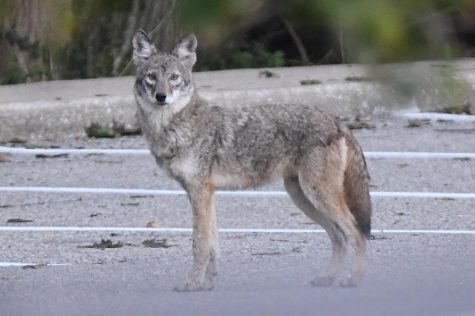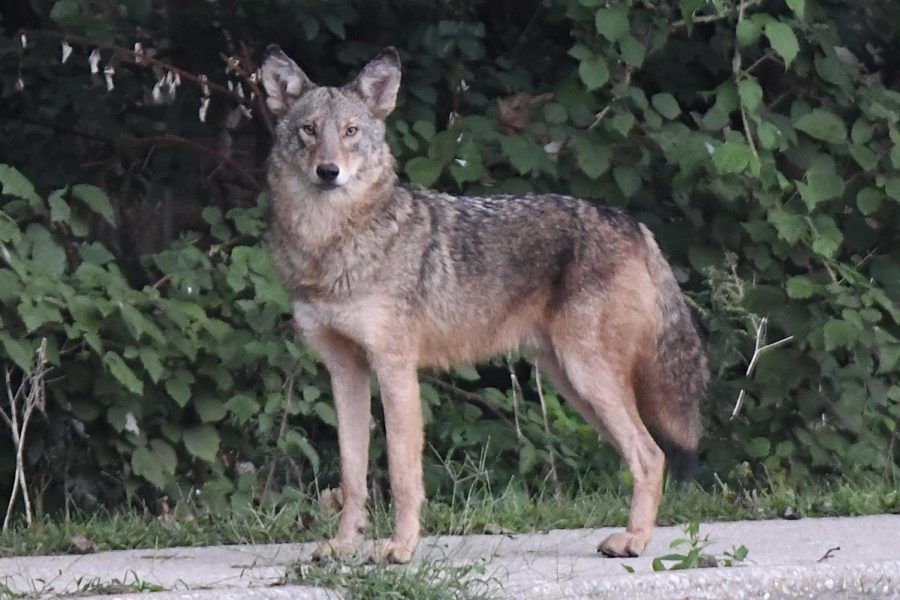A New Sheriff in Town
A Current and Historical Understanding of Hastings’ Coyotes
An adult Eastern Coyote in Hillside Woods.
October 27, 2021
Since the infamous “Coyote Days” of March 2018, when Hastings residents wandered the streets with bats while students were forbidden from walking home, coyotes have come to embody a menacing wilderness lurking in the shadows. Yet the brash aggression of that particular coyote from 2018 was an anomaly. Setting it apart from its more docile counterparts, it had rabies — a behavior-altering disease spread through the saliva of mammals. One behavioral change associated with rabies is an increase in boldness and hostility levels, which often causes shy, mostly nocturnal animals to hunt in broad daylight. The rabid coyote that prowled Hastings’ streets four years ago has since been removed, killed within weeks of its arrival, but coyotes are far from absent within the town’s borders.

A Welcome Surprise
The coyotes that still inhabit Hastings are characteristically “coy.” They are meek around humans, inquisitive of our presence but inclined to remain concealed and avoid interactions. While coyotes have long been spotted on the streets of Hastings, they are normally solitary, lone individuals passing through to find a territory. This year, however, broke that pattern when multiple coyotes were noted repeatedly in Hillside Woods, a 100 acre forest in Hastings. First there was one adult, then two. Soon, two pups appeared, marking the first documented breeding of coyotes in Hillside Woods in at least 17 years. While the young were raised along the park’s Algonquin Trail, all four coyotes are known to roam the full extent of the woods in addition to nearby roads.
The new presence of coyotes in Hillside has returned needed balance to this ravaged ecosystem, with the residence of a large predator helping to control herbivorous species. Although minimal evidence has been collected on these coyotes’ eating habits, Hillside hosts a plethora of food options. Based on research from other New York populations, these four coyotes are likely eating small-to-medium sized mammals, such as meadow voles, eastern cottontail, and white-tailed deer fawns, in addition to certain fruits and nuts. Still, with the exception of larger packs, the diminutive size of coyotes means they lack the strength to hunt fully-grown white-tailed deer. Thus, they fail to replace the role of the eastern gray wolf, a deer specialist which was hunted to extinction in New York by 1900.

A Blended Background
Yet, Hillside’s coyotes hide their most interesting facet from the untrained eye: they are not even coyotes at all. Following the extirpation of gray wolves and mountain lions from the Northeast in the mid-1800s, western coyotes, the “pure” coyote, spread from their desert origins into the Midwest, no longer restricted to a small range by larger predators. Midwestern gray wolves, at this time facing extinction as well, were desperate to breed, so they hybridized with the western coyotes. The offspring of these wolf-coyote pairs — colloquially, and sometimes scientifically, referred to as coywolves — expanded further until reaching the Eastern Seaboard. Today, the eastern coyote — a more agreed upon term for “coywolf” — inhabits the entirety of the east coast. Its genome is composed of gray wolf, western coyote, and even domestic dog DNA.
As a result, eastern coyotes, including the Hillside ones, differ in many ways from their western cousins. Structurally, coywolves, on average, are much larger than true coyotes, weighing between 35-55 lbs compared to 20-25 lbs, respectively. Their stocky build, coupled with a larger jaw, longer legs, and the contours of a wolf body, make eastern coyotes adept at taking down larger prey. Gray wolf genes make coywolves more social than western coyotes; they tend to hunt in small packs, which aids their ability to hunt large mammals. In terms of vocalizations, eastern coyotes often begin their communications with a howl, a wolf trademark, and end with yips and barks, typical for western coyotes.

Two Alphas, One Town
As humans encroach further into nature, they more frequently engage with wildlife. Coywolves derive their genes from an excellent host of parent species, allowing them to be incredibly adaptable in the face of urbanization. In Hastings, the proximity of Hillside and neighborhoods makes human-coyote relations inevitable, and coexistence with coywolves is a necessity. Like all animals, eastern coyotes are protective of their young. They will resort to scare tactics, such as charging, or violence to fend off possible threats. These actions are rarely directed at humans; rather — as is the case in Hillside — they are most often provoked by dogs that approach the pups or den site. Similarly, dogs may sense adult coyotes and attempt to search them out, leading to interactions with unfortunate outcomes.
Still, coywolves are situated firmly within Hastings’ ecology. With year-round residents in Hillside, as well as Rowley’s Bridge Trail along the waterfront, it’s time for the village to accept a future with these hybridized canids.


















